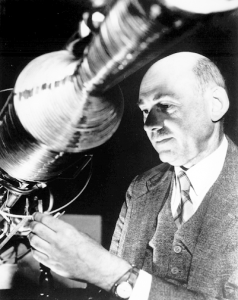
Each year since 1961, NASA’s Goddard Space Flight Center has presented Robert H. Goddard Awards for exceptional achievement. The award was named in honor of Robert Hutchings Goddard—a man considered a father to both rocketry and the U.S. space program, and the eponymous physicist behind this NASA field center.
The final selections for the 2013 Robert H. Goddard awards were announced in February 2014. There are 15 award categories and staff from the Landsat 8 project won awards in five of these. The Landsat 8 recipients are:
The Robert H. Goddard Award for Engineering
Edward Grems (AI Solutions, Inc.)
Ted was the Landsat 8 Mission Systems Engineer. He and his team made sure the two Landsat 8 science instruments (OLI and TIRS) could interface with the spacecraft. He was responsible for making sure both instruments had adequate power, working data communication channels, appropriate ambient temperatures, and good mechanical interfaces with the spacecraft. Ted spent lots of time traveling between Boulder, Colo., Phoenix, Ariz., and Sioux Falls, S.D. to work with his “talented counterparts” at Ball Aerospace and Technology Corp. (OLI’s builder), Orbital Sciences Corp. (the spacecraft builder), and USGS EROS (NASA’s Landsat 8 partner and lead for the ground system).
Landsat 8’s success was “due to a great team effort. From requirements development to seeing the realization of actual science data, I enjoyed the challenges,” Ted shares.
Ted, who got his pilot’s license before his driver’s license, says, “I have always loved both the ‘aero’ and ‘space’ sides of aerospace.”
Prior to working on Landsat 8, Ted worked on the Space Shuttle’s first launch, National Aero-space Plane research, Delta II rockets, and the QuikSCAT and QuikTOMS projects.
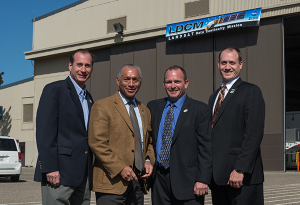
Dave was the Electrical Systems Lead for Landsat 8, you can think of Dave as “The Closer.” Dave joined Landsat as it was completing its build and approaching “single line flow.” During single line flow, the spacecraft and instruments are run through rigorous environmental testing to ensure the spacecraft will successfully operate in its harsh space environment. Dave managed the electrical testing in both Arizona where the spacecraft and instruments were integrated and at Vandenberg Air Force Base in California where Landsat 8 was launched, helping to resolve any anomalous results along the way.
Dave (a huge Philadelphia Flyers fan) has launched 13 satellites from four different launch locations.
Travis Chezick (General Dynamics Corp.)
Travis was the Ground Readiness Manager for Landsat 8 in the two years leading up to launch (before that he was a systems engineer for the Mission Operations Element); think of Travis as a Utility Player. He was responsible for making sure that the Mission Operations Center, or MOC, was ready for launch. This involved combining a lot of computers and lots of highly specific software together to ensure that the MOC team could talk to the spacecraft and fluently communicate information needed to keep Landsat 8 operating smoothly after launch. A lot of Travis’ time was spent on system integration and testing, i.e., a lot of “dress rehearsals” went into getting Landsat 8 ready for show time. In the stressful pre-launch realm, Travis—who grew up in International Falls, Minnesota, “The Icebox of the Nation,” where cold weather was celebrated—knew how to stay cool (despite occasional hot-headedness).
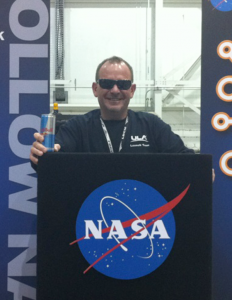
Jerry was the Deputy Observatory Manager for Landsat 8 prior to launch. He is a problem solver. You can think of him as “The Wolf,” à la Pulp Fiction. Jerry managed the team from Goddard that worked with the spacecraft builder (Orbital Sciences Corp.) to test the Landsat 8 spacecraft and instruments prior to launch; he helped develop the Launch Countdown Timeline that specified what had to happen when to be ready for blast off; and, he was involved in the delivery of the spacecraft to the launch site at Vandenberg—where over the course of his 25-year career, he has spent approximately 1000 days.
Fortunately, Jerry says: “I have a wonderful wife and two children that are extremely supportive and understanding of my work which requires me to travel to contractor’s facilities and launch sites for extensive periods of time.”
James Storey (SGT Inc.)
Jim is the Geometric Calibration/Validation Lead for Landsat 8—an unquestionably essential part of Landsat’s “Geometry Team.”
“It is our job to figure out how to geolocate—or relate to a ground coordinate system—each image pixel so that we can turn our calibrated images into geographically referenced data products,” Jim explains. By combining information from the spacecraft about where it is located (via a GPS receiver) and where it is pointing (based on star tracker measurements) with geometric models of the two Landsat 8 science instruments (OLI and TIRS), Jim can project the lines-of-sight from the instruments’ imaging detectors to Earth’s surface, and thereby accurately tell us where on Earth every given Landsat pixel falls.
Jim is a big lacrosse fan. Fortunately for Landsat data users, he shares some key traits with his favorite sport: he’s quick, goal-oriented, and good with angles and trajectories.
Philip Dabney (NASA)
Phil was the Landsat 8 Instrument Scientist, unofficially the “Man of Many Hats.” He worked where the realms of Landsat 8 science and engineering met. On the science side he helped develop the instrument science requirements—the specifications or “specs” that established what measurements the instruments were required to make. He then worked closely with the instrument systems engineers as they interpreted and translated these “specs” into a systems engineering flow-down, i.e. “how do we make this happen?”
While the instrument was being designed and built, Phil made sure that engineering trade-offs needed for system performance did not leave the instruments out of science spec. He helped describe what science impacts these trade-offs would have and he worked to find solutions when related issues arose. Phil is also a member of the Landsat 8 calibration and validation team.
Fun fact: Phil loves to hike in the cold rain (good thing he is used to wearing so many hats.)
LDCM Observatory Team
The Landsat 8 Observatory Team was made up of some 115 people. Together they were a critical part of Landsat 8’s success.
The Robert H. Goddard Award for Science
Landsat Calibration/Validation Team (Brian Markham)
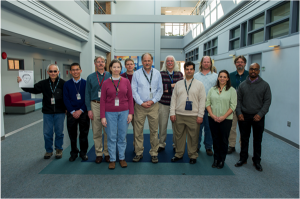
Brain and the CVT were responsible for making Landsat 8 data as good as it possibly could be for the scientific user community. His team was involved, “all the way from defining requirements to calibrating the instruments and data on-orbit.”
The team spanned three U.S. time zones and had one team member regularly joining from Singapore. Recently, the team has expanded to include Sentinel-2 contacts in Europe—all of which makes scheduling telecoms a challenge!
The Robert H. Goddard Award for Customer Service
Karla Kahler (ASRC Research & Tech. Solutions)
Karla was the Project Support Manager for Landsat 8. She helped make sure that the special shipping container built for the spacecraft made it safely from where it was built in Ottawa, Ohio to Gilbert, Arizona where it was loaded with the spacecraft and then on to Vandenberg. She helped ensure that the launch team had everything it needed at Vandenberg, plus she supported day-to-day office activities, so that the Landsat 8 team could focus on satellite issues.
Despite a challenging launch schedule, Karla was one of “The Believers,” who never gave up on making the February 11, 2013 launch even when technical issues made things difficult. Thanks to the extraordinary efforts of the team, that launch date was made.
“The team was very unique in how they worked together, everyone always pitched in where needed whether it was their job or not and everyone was treated like family,” she shares. Karla, who is also a Volunteer Emergency Medical Responder, thrives in a high-pressure environment.
Landsat 8 Spacecraft Transporter Team (Nilesh Patel)
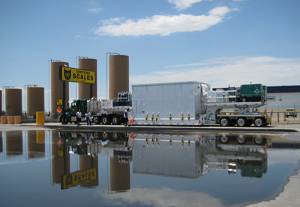
The Landsat 8 transportation team is the same Goddard group that has successfully moved dozens of NASA spacecraft and flight hardware across the country and around the globe.
These large-scale shipments of flight hardware can be safely conducted because each team member provides a specific expertise. This ensures every facet of the transport operation can be successfully accomplished.
As Neil explains, “Moving these missions from one facility to the next is a complex orchestrated event which requires years of engineering and planning. The shipment itself is a large team effort requiring a good deal of hard labor and enduring hours.”
Landsat 8 Ground & Operations Integration Team (Victor Gehr/John Hughes)
This team had to make sure that the Landsat 8 ground system and the Mission Operations Element—i.e., the heart and soul of ground communications for Landsat-8—was tested, verified, and validated. They had to ferret out all potential problems and find a fix.
“We were the ‘Whack-A-Mole Engineering Team.’ When a problem popped up, we knocked it down,” John Hughes, a team lead remarks.
Long, long hours became the norm for many of the teams working on Landsat 8 prior to launch. When a comment was made that the Ground & Operations Integration Team gave 110% all of the time, Hughes commented that the calculation would need to be revised, because 110% was a mere 44 hours a week. Hughes’ team was made up of a core of ten engineers that surged to 12 for launch. Additionally, Hughes led a Capitol College Intern Team made up of six core engineering interns that surged to ten for the first two weeks after launch when the team was needed around-the-clock. Hughes and his team were ready for the long days and nights needed to get the job done; collectively, they were known as the “Rock Stars.”
“The comment of my resemblance to Keith Richards was greatly—okay, somewhat—exaggerated,” say Hughes.
The Robert H. Goddard Award for Professional Administrative
Sandra Sumner (NASA)
Sandra was a Financial Manager for Landsat 8. She was the person who made sure all of Landsat 8’s financial obligations were met. She’s good with numbers and words—an avid reader, Sandra read over 90 books in 2013.
The Robert H. Goddard Award for Leadership
Vicki Dulski (NASA)
Vicki was the Ground System and Operations Manager for Landsat 8. She led the team that built and operated the Landsat 8 ground system. Her team was responsible for developing the software and hardware that was used by the Mission Operations Center to talk to and monitor Landsat 8. The team closely collaborated with USGS—“a great mission partner”—who took over Landsat operations after the initial on-orbit checkout period.
Vicki’s engineers staffed the MOC around-the-clock leading up to Landsat 8’s launch and during the early phases of the mission. Her core team of 20-25 engineers closely monitored Landsat 8 for any unexpected signs of trouble during the commissioning process.
Vicki is a “Yooper”—born and raised on Michigan’s Upper Peninsula, or U.P. She and her ground system team were spectacularly important to Landsat 8’s success (eh).
Dennis Reuter (NASA)
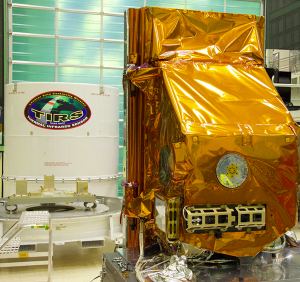
Once the TIRS concept was designed, the build began. Dennis’ team grew. The team had to then design and implement tests for TIRS subsystem engineering models so they could answer how various technical trade-offs would impact performance. This was essential for ensuring the as-built TIRS would meet spec.
“We also were responsible for calibrating the instrument—that is, for determining the relationships that convert the signals measured by TIRS into scientifically usable units and for measuring instrument parameters such as pointing direction and spatial/spectral characteristics,” Dennis describes.
Dennis and his team continued to help with TIRS calibration and validation after Landsat 8’s launch. They made sure their pre-launch calibration work was successfully implemented by USGS EROS (where Landsat 8 data is processed and distributed) and they also helped verify TIRS’ on-orbit performance. While Dennis’ TIRS science team no longer exists, he is still helping the Landsat 8 Cal/Val team with their thermal work. He helps with ongoing assessments and proposes and evaluates improved data processing methods.
Dennis and his team referred to the fast delivery schedule for TIRS as “sporty.”
He says, “TIRS was built by a truly amazing team at Goddard with industrial partners across the nation. To have delivered such an outstanding instrument on the… sporty schedule required to meet the launch date was a remarkable accomplishment. It was an honor and privilege to work with such a talented group of people.”
The awards ceremony will be held at NASA Goddard on May 8, 2014.






